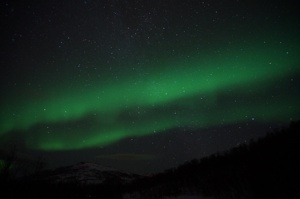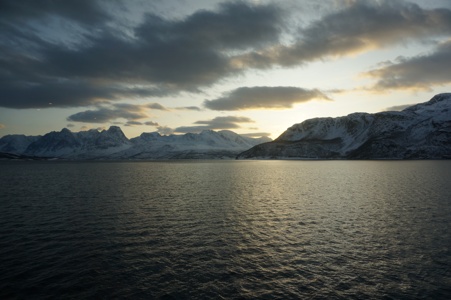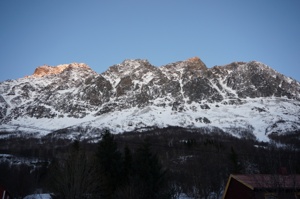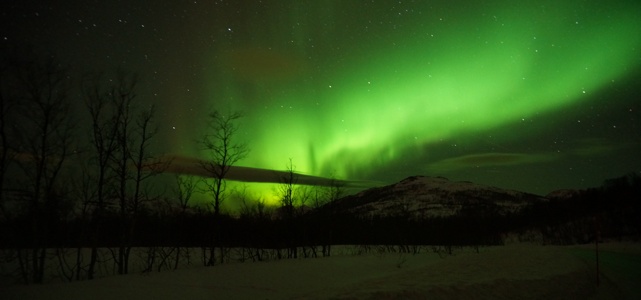It's no secret that I'm not a fan of hot weather; given the choice between a nice, hot beach and a cold, icy mountain, I'll pick the latter every time. Thus, it's not entirely surprising that, when faced with the opportunity for one last European trip before I move to the US, I chose to go to Norway.
In particular, I chose to go to Tromsø, one of the world's most northerly cities. The reasoning was twofold - firstly, to visit an area with some stunning natural scenery and to drive around and see some fjords, and secondly, to see the Northern Lights (Aurora Borealis).
Expecting to see the aurora when you're only somewhere for two nights is perhaps a bit of a stretch, but Tromsø is incredibly well-placed right in the middle of the auroral oval, and this time of year (January - March) it has nice dry weather so there's less cloud cover.
Fortunately, even despite some travel setbacks, I managed to see the Northern Lights, and even managed some half-decent photos of them.
The pictures are somewhat misleading - they're not quite as colourful and saturated as photographs show them to be, but there's also a much grander sense of scale in person (they're very high in the atmosphere, something photographs can fail to convey).
I only saw a weak auroral display - the Sun wasn't particularly active that night, and it's the solar wind that drives the aurora - but it was impressive nonetheless. Catching a bigger solar event is much more hit-and-miss, and you'll probably need to camp outside for several weeks to even get a chance.
I'll cover the logistics and effort involved in seeing the Northern Lights for yourself later on, but first let me talk about getting to Tromsø itself.
Getting there
DY2470 (LGW » TOS)
DY381 (TOS » OSL)
DY1310 (OSL » LGW)
While Tromsø is deep in northern Norway and inside the Arctic Circle, it has a nice airport and a very decent set of flights to destinations both inside Norway and beyond. In particular, there's a direct flight from London three times a week, which is what I opted for on my outward leg.
Unfortunately, the plane that was due to fly to Tromsø didn't have fully working thrust reversers, and as it's a relatively small, icy runway they instead flew us to Oslo (Norwegian Air's hub) and moved us to a new plane that then immediately flew to Tromsø.
It was a four hour delay, but given the conditions I'm fine with them making the safety call. The amount of logistics that go into making regular passenger flights happen in Arctic conditions is amazing - at Oslo, where it was sub-zero and snowing the entire time, a fleet of vehicles continuously clears the runway of snow, and every departing plane is leaped on by four specialised trucks that shower every important surface with de-icing fluid.
Taxiing round Oslo, you just see endless expanses of snow, and entire groups of aircraft completely iced over as they've been sitting there for more than a few days. The fact that it's possible, let alone economical, to run regular passenger flights with full-size Boeing 737s in those conditions is amazing.
Norwegian also hits above its weight for an ostensibly low-cost airline - most of my flights had free WiFi on board, the seats weren't ridiculously close together, and the cabin crew were very friendly. They're introducing more transatlantic flights this year, too, including two routes to San Francisco, which should be interesting to watch.
Getting around
Tromsø is actually a relatively big place, and as it as no trains or trams, road transport is essential to getting around.
As I was planning to drive outside the city and see some of the surrounding countryside, I opted to rent a car (most major car rental companies are represented at the airport, even if they only have about 4 cars each), but there's quite good local buses and, of course, taxis.
The taxis are, like most things in Norway, really quite expensive - the base fare is something like 80 NOK (£8 / $13), and for a journey of just over a mile I paid 140 NOK. That said, they're all metered and incredibly friendly, which is more than I can say for some cities' taxis.
If you are renting a car in winter, it's very likely that it'll come winterised (snow tyres, lower viscosity oil, etc.), but it's worth checking. Driving on snow and ice is also trickier than you might expect - make sure you take it slow and allow plenty of time to decelerate.
The roads in Troms county were all well-cleared and generally had only a thin layer of packed snow on them, if anything - it was a relatively easy driving experience. That said, never approach winter driving lightly; always carry warm clothes, food and drink, and make sure the car is in full working order before you depart.
The city
Tromso is a decently-sized city for its location, and thanks to the Gulf Stream it's a lot warmer than it should be for its latitude (temperatures during the day hovered around -3°C).
There are a couple of tourist attractions - some museums, two cathedrals, and departing boat tours - as well as a decent number of supermarkets and shops. Everything is expensive, but that's the case in Norway anyway.
I spent a couple of hours wandering and driving around Tromsø, but didn't have time for any museums; I wanted to go and see the more rural parts of this part of Norway and I only had four hours of daylight in which to do it.
If you do go in the wintertime, remember that it's dark for 20 hours a day and that you can't exactly lounge around outside and enjoy the atmosphere - but you'll probably be out at night trying to see the lights if you're anything like me.
Troms County
As well as the lights I was also here to see some of the incredible natural environment in this part of the world. I picked Lyngen as my destination - a place that several travel guides said was particularly impressive, and which was only two hours' drive from Tromsø.
I had a wonderful day driving there and back (via different routes), even getting a ferry across a fjord on the way there. The grandeur of the landscape is wonderful; giant mountains rise kilometres above the flooded fjords, and you feel tiny as you wind your car round the edge of the water and through the mountain tunnels.
It can get pretty cold in some of the higher areas, though - at one point my car's thermometer read -14°C - so while you can get out of the car to look around, you really can't do it for very long. I had full winter gear (which really tested my hand-luggage-only rule for holidays), but as you'll likely be keeping the inside of the car warm it can be a hassle to get it all on.
If you're an experienced skier I have it on good authority that the mountains around Lyngen are some of the best off-piste in the world. Perhaps one day I'll go back and try that; it would be great to see the landscape from higher up!
Viewing the Aurora
Once I'd got back from Lyngen, I stopped by the hotel for a nap, and then went out in search of the aurora at about 8pm. The peak of auroral activity is usually around 10pm, and I had to drive far enough out of Tromsø that I would avoid its light pollution. In the end I only drove about half an hour away from Tromso, but if I wanted an entirely dark sky I would have had to go at least twice as far; it's really quite impressive how much light that city puts out.
Once I'd found a nice dark, quiet spot (nothing like other cars' headlights ruining your night vision), I sat and let my eyes adjust to the dark, and then slowly started seeing the aurora.
As I mentioned above, it's a lot dimmer than the pictures would have you believe, though I did see it on a low-activity night, so it does get brighter. The scale and size of it is hard to convey - it dominates the sky once you notice it, and it moves just slowly enough that it looks static at first.
Taking photos of it is much like other astrophotography - as big an aperture as possible, very long exposures, a high ISO and a tripod. I was using a Gorillapod propped up on a bank of snow and the camera's self-timer so there was no hands touching the camera when the shutter opened.
I'd recommend taking food with you as well - while I was waiting for the aurora to appear or get stronger, I sat in the car listening to podcasts (a screen would have ruined my night vision) and eating delicious Norwegian snacks.
Conclusions
If you go to Tromsø, I recommend going for at least three nights and definitely get out of the city to see some of the landscape around it. There's a cable car up the nearby mountain to see the city from, as well, plus boat tours in and out of the fjords to keep you occupied.
If you're there for a very long time, you could always pop on one of the many flights up to Svalbard and get really far north - next time I visit, I fully intend to.
I'm very glad with my three day trip, though - it's crossed two things off of my bucket list, and it was beautiful to boot. Cold, snowy holidays might not be for everyone, but if they're your thing, you should go!
You can see more pictures from this trip on Flickr






